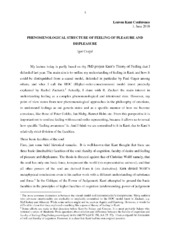Phenomenological Structure of Feeling Of Pleasure And Displeasure
Апстракт
I will present the basics of Kant’s understanding of feelings. and specifically, try to show why we should not accept some conclusions of interpretations offered by Paul Guyer and Rachel Zuckert.
In his interpretation of Third Critique, Paul Guyer that feelings are an inexplicable sensation, which can be explained in no other way than through its causes. Guyer insists on equalizing sensations and feelings. However, sensations are (according to Kant) the kind of presentations that appear as impressions of our outer senses. Additionally, in the Critique of Pure Reason, Kant explains that only material for inner sense are outer sensations. (KrV, AA 03: 23,70; Allison 1983, 277) Feelings, on the contrary, do not provide new material of inner sense. (V-Met/Dohna, AA 28: 673) It is therefore impossible to hold that feelings are somehow new sensations that appear in our inner sense.
According to Zuckert, feelings can be understood as second-order consciousness, that has as its contents an...y other kind of representation (sensation, intuition or concept) and represents a formal relational characteristic of this content, with a tendency to persist. Unlike Guyer, Zuckert differentiates feelings from sensations, and like Guyer, correctly emphasizes that feelings are not discursive representations. (Zuckert 2007, 236) However, in her reading, feelings are a representation and their main function is cognitive, representational (Zuckert 2007, 233), which is exactly what the faculty of feeling does not do. I would argue that Zuckert’s interpretation fails to address definition of displeasure in §10. of Critique of the power of judgement, and both Guyer’s and Zuckert’s interpretation could not follow literally definition in §12. – Guyer modified a translation and Zuckert finds it is ‘a slip’.
The crucial challenge set by Kant is to characterize feeling as sui generis mental state, which means as a mental state that is not representation. Based on evidence in Kant’s lectures and major works I will argue that feeling in Kant’s works should be understood as an exercise of a causal power of representation for maintaining or hindering its state of representing (V-Met/Dohna, AA 28: 675). I will argue that Kant suggests that causality of representation does not demand higher-order-consciousness for us to be aware of it, but is rather one of the ways (“entirely special faculty of discriminating”) in which we come to be aware and itself manifests as awareness. Thus, we can keep to the formal structure that consists of representation and its relational property (to maintain its state), while avoiding some contradictions that emerge with the introduction of second-order consciousness. Feelings are a complex phenomenological structure that consists of two components: (1) cognitive component, representations themselves (sensation, intuition or concept) and (2) causal component, its tendency toward maintaining its state of representation (subjective causality). These two components in one feeling are of course, not separable. Subjective causality of representation is not a new, additional thing, on top of the representation itself, but a subjective characteristic (Beschaffenheit) of a cognitive state, one, albeit, which cannot be reduced to the cognitive state itself.
Кључне речи:
Kant, Imanuel / feelingИзвор:
Leuven Kant Conference, 2018Колекције
Институција/група
IFDTTY - CONF AU - Cvejić, Igor PY - 2018 UR - http://rifdt.instifdt.bg.ac.rs/123456789/1913 AB - I will present the basics of Kant’s understanding of feelings. and specifically, try to show why we should not accept some conclusions of interpretations offered by Paul Guyer and Rachel Zuckert. In his interpretation of Third Critique, Paul Guyer that feelings are an inexplicable sensation, which can be explained in no other way than through its causes. Guyer insists on equalizing sensations and feelings. However, sensations are (according to Kant) the kind of presentations that appear as impressions of our outer senses. Additionally, in the Critique of Pure Reason, Kant explains that only material for inner sense are outer sensations. (KrV, AA 03: 23,70; Allison 1983, 277) Feelings, on the contrary, do not provide new material of inner sense. (V-Met/Dohna, AA 28: 673) It is therefore impossible to hold that feelings are somehow new sensations that appear in our inner sense. According to Zuckert, feelings can be understood as second-order consciousness, that has as its contents any other kind of representation (sensation, intuition or concept) and represents a formal relational characteristic of this content, with a tendency to persist. Unlike Guyer, Zuckert differentiates feelings from sensations, and like Guyer, correctly emphasizes that feelings are not discursive representations. (Zuckert 2007, 236) However, in her reading, feelings are a representation and their main function is cognitive, representational (Zuckert 2007, 233), which is exactly what the faculty of feeling does not do. I would argue that Zuckert’s interpretation fails to address definition of displeasure in §10. of Critique of the power of judgement, and both Guyer’s and Zuckert’s interpretation could not follow literally definition in §12. – Guyer modified a translation and Zuckert finds it is ‘a slip’. The crucial challenge set by Kant is to characterize feeling as sui generis mental state, which means as a mental state that is not representation. Based on evidence in Kant’s lectures and major works I will argue that feeling in Kant’s works should be understood as an exercise of a causal power of representation for maintaining or hindering its state of representing (V-Met/Dohna, AA 28: 675). I will argue that Kant suggests that causality of representation does not demand higher-order-consciousness for us to be aware of it, but is rather one of the ways (“entirely special faculty of discriminating”) in which we come to be aware and itself manifests as awareness. Thus, we can keep to the formal structure that consists of representation and its relational property (to maintain its state), while avoiding some contradictions that emerge with the introduction of second-order consciousness. Feelings are a complex phenomenological structure that consists of two components: (1) cognitive component, representations themselves (sensation, intuition or concept) and (2) causal component, its tendency toward maintaining its state of representation (subjective causality). These two components in one feeling are of course, not separable. Subjective causality of representation is not a new, additional thing, on top of the representation itself, but a subjective characteristic (Beschaffenheit) of a cognitive state, one, albeit, which cannot be reduced to the cognitive state itself. C3 - Leuven Kant Conference T1 - Phenomenological Structure of Feeling Of Pleasure And Displeasure UR - https://hdl.handle.net/21.15107/rcub_rifdt_1913 ER -
@conference{
author = "Cvejić, Igor",
year = "2018",
abstract = "I will present the basics of Kant’s understanding of feelings. and specifically, try to show why we should not accept some conclusions of interpretations offered by Paul Guyer and Rachel Zuckert.
In his interpretation of Third Critique, Paul Guyer that feelings are an inexplicable sensation, which can be explained in no other way than through its causes. Guyer insists on equalizing sensations and feelings. However, sensations are (according to Kant) the kind of presentations that appear as impressions of our outer senses. Additionally, in the Critique of Pure Reason, Kant explains that only material for inner sense are outer sensations. (KrV, AA 03: 23,70; Allison 1983, 277) Feelings, on the contrary, do not provide new material of inner sense. (V-Met/Dohna, AA 28: 673) It is therefore impossible to hold that feelings are somehow new sensations that appear in our inner sense.
According to Zuckert, feelings can be understood as second-order consciousness, that has as its contents any other kind of representation (sensation, intuition or concept) and represents a formal relational characteristic of this content, with a tendency to persist. Unlike Guyer, Zuckert differentiates feelings from sensations, and like Guyer, correctly emphasizes that feelings are not discursive representations. (Zuckert 2007, 236) However, in her reading, feelings are a representation and their main function is cognitive, representational (Zuckert 2007, 233), which is exactly what the faculty of feeling does not do. I would argue that Zuckert’s interpretation fails to address definition of displeasure in §10. of Critique of the power of judgement, and both Guyer’s and Zuckert’s interpretation could not follow literally definition in §12. – Guyer modified a translation and Zuckert finds it is ‘a slip’.
The crucial challenge set by Kant is to characterize feeling as sui generis mental state, which means as a mental state that is not representation. Based on evidence in Kant’s lectures and major works I will argue that feeling in Kant’s works should be understood as an exercise of a causal power of representation for maintaining or hindering its state of representing (V-Met/Dohna, AA 28: 675). I will argue that Kant suggests that causality of representation does not demand higher-order-consciousness for us to be aware of it, but is rather one of the ways (“entirely special faculty of discriminating”) in which we come to be aware and itself manifests as awareness. Thus, we can keep to the formal structure that consists of representation and its relational property (to maintain its state), while avoiding some contradictions that emerge with the introduction of second-order consciousness. Feelings are a complex phenomenological structure that consists of two components: (1) cognitive component, representations themselves (sensation, intuition or concept) and (2) causal component, its tendency toward maintaining its state of representation (subjective causality). These two components in one feeling are of course, not separable. Subjective causality of representation is not a new, additional thing, on top of the representation itself, but a subjective characteristic (Beschaffenheit) of a cognitive state, one, albeit, which cannot be reduced to the cognitive state itself.",
journal = "Leuven Kant Conference",
title = "Phenomenological Structure of Feeling Of Pleasure And Displeasure",
url = "https://hdl.handle.net/21.15107/rcub_rifdt_1913"
}
Cvejić, I.. (2018). Phenomenological Structure of Feeling Of Pleasure And Displeasure. in Leuven Kant Conference. https://hdl.handle.net/21.15107/rcub_rifdt_1913
Cvejić I. Phenomenological Structure of Feeling Of Pleasure And Displeasure. in Leuven Kant Conference. 2018;. https://hdl.handle.net/21.15107/rcub_rifdt_1913 .
Cvejić, Igor, "Phenomenological Structure of Feeling Of Pleasure And Displeasure" in Leuven Kant Conference (2018), https://hdl.handle.net/21.15107/rcub_rifdt_1913 .



 ,
,